Recycled and Virgin HDPEs as Bleed Inhibitors and Their Rheological Influences on Lubricating Greases Thickened with PP and mPP
Abstract
:1. Introduction
2. Experimental Section
2.1. Materials
2.2. Grease Manufacturing
| Sample | MFI * (g/10 min) | Density * | Mw | Mn | Mw/Mn | Tm | ΔHf |
|---|---|---|---|---|---|---|---|
| Polypropylene (PP) | 1700 | n.a. | 1.20 × 105 | 3.8 × 104 | 3.2 | 161.5 | 102 |
| Maleated Polypropylene | 120 | n.a. | 1.42 × 105 | 5.1 × 104 | 2.8 | 160 | 109 |
| (mPP) | |||||||
| HDPE | 0.9 | 0.952 | 5.73 × 105 | 4.6 × 104 | 12 | 132 | 237 |
| Recycled HDPE (rHDPE) | 1.55 | n.a. | 3.95 × 105 | 3.3 × 104 | 11.9 | 131.5 | 219 |
| Sample | % of PP | % of HDPE | % of rHDPE | Sample | % of mPP | % of HDPE | % of rHDPE |
|---|---|---|---|---|---|---|---|
| PP18 | 18 | nil | nil | mpp15.5 | 15.5 | nil | nil |
| PP17.5 | 17.5 | nil | nil | mPP15 | 15 | nil | nil |
| PP17 | 17 | nil | nil | mPP14.5 | 14.5 | nil | nil |
| PP16 | 16 | nil | nil | mPP13.5 | 13.5 | nil | nil |
| PP14 | 14 | nil | nil | mPP11.5 | 11.5 | nil | nil |
| PP+HDPE0.5 | 17.5 | 0.5 | nil | mPP+HDPE0.5 | 15 | 0.5 | nil |
| PP+HDPE1 | 17 | 1 | nil | mPP+HDPE1 | 14.5 | 1 | nil |
| PP+HDPE2 | 16 | 2 | nil | mPP+HDPE2 | 13.5 | 2 | nil |
| PP+HDPE4 | 14 | 4 | nil | mPP+HDPE4 | 11.5 | 4 | nil |
| PP+rHDPE0.5 | 17.5 | nil | 0.5 | mPP+rHDPE0.5 | 15 | nil | 0.5 |
| PP+rHDPE1 | 17 | nil | 1 | mPP+rHDPE1 | 14.5 | nil | 1 |
| PP+rHDPE2 | 16 | nil | 2 | mPP+rHDPE2 | 13.5 | nil | 2 |
| PP+rHDPE4 | 14 | nil | 4 | mPP+rHDPE4 | 11.5 | nil | 4 |
2.3. Gel Permeation Chromatography
2.4. Differential Scanning Calorimetry
2.5. Heat Stability Test
2.6. Cone Penetration Test
2.7. Rheological Studies
3. Results and Discussion
3.1. Differential Scanning Calorimetry
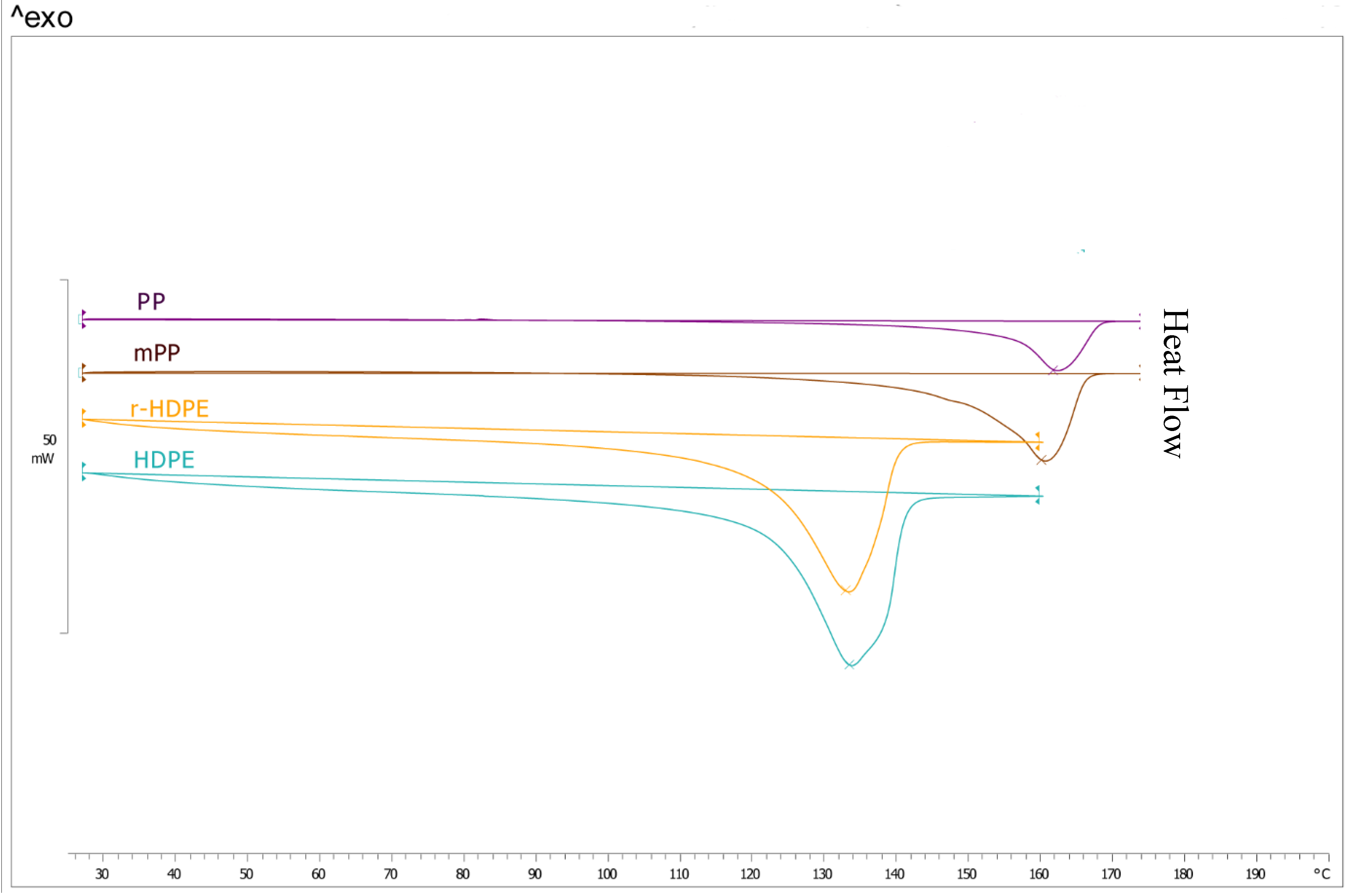
3.2. Heat Stability
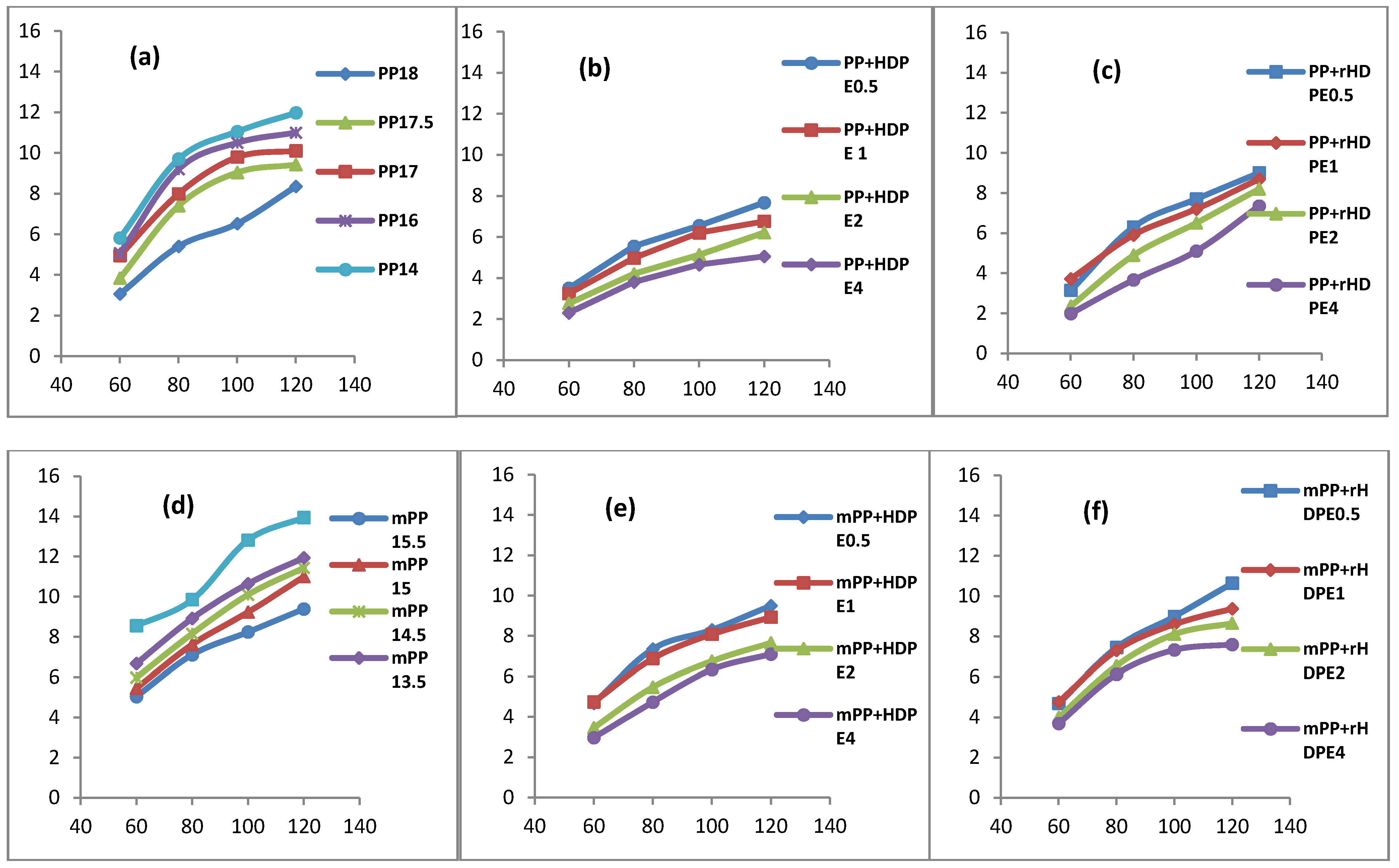
3.3. Cone Penetration Test
| Sample | Unworked Penetration | Worked Penetration | GN0 | Sample | Unworked Penetration | Worked Penetration | GN0 |
|---|---|---|---|---|---|---|---|
| PP18 | 217 | 269 | 86,700 | mpp15.5 | 231 | 287 | 81,300 |
| PP17.5 | 235 | 279 | 71,500 | mPP15 | 257 | 303 | 57,400 |
| PP17 | 259 | 291 | 56,300 | mPP14.5 | 265 | 311 | 56,100 |
| PP16 | 279 | 303 | 52,700 | mPP13.5 | 275 | 315 | 40,900 |
| PP14 | 293 | 337 | 17,266 | mPP11.5 | 315 | 345 | 15,700 |
| PP+HDPE0.5 | 217 | 271 | 78,833 | mPP+HDPE0.5 | 243 | 293 | 52,950 |
| PP+HDPE1 | 241 | 277 | 78,166 | mPP+HDPR1 | 253 | 289 | 59,620 |
| PP+HDPE2 | 237 | 275 | 87,920 | mPP+HDPE2 | 243 | 285 | 77,250 |
| PP+HDPE4 | 225 | 263 | 115,666 | mPP+HDPE4 | 211 | 269 | 122,000 |
| PP+rHDPE0.5 | 231 | 281 | 83,100 | mPP+rHDPE0.5 | 243 | 295 | 58,100 |
| PP+rHDPE1 | 235 | 279 | 81,300 | mPP+rHDPE1 | 243 | 291 | 58,725 |
| PP+rHDPE2 | 219 | 277 | 89,100 | mPP+rHDPE2 | 227 | 273 | 87,600 |
| PP+rHDPE4 | 207 | 253 | 124,000 | mPP+rHDPE4 | 227 | 267 | 97,300 |
3.4. Rheological Studies
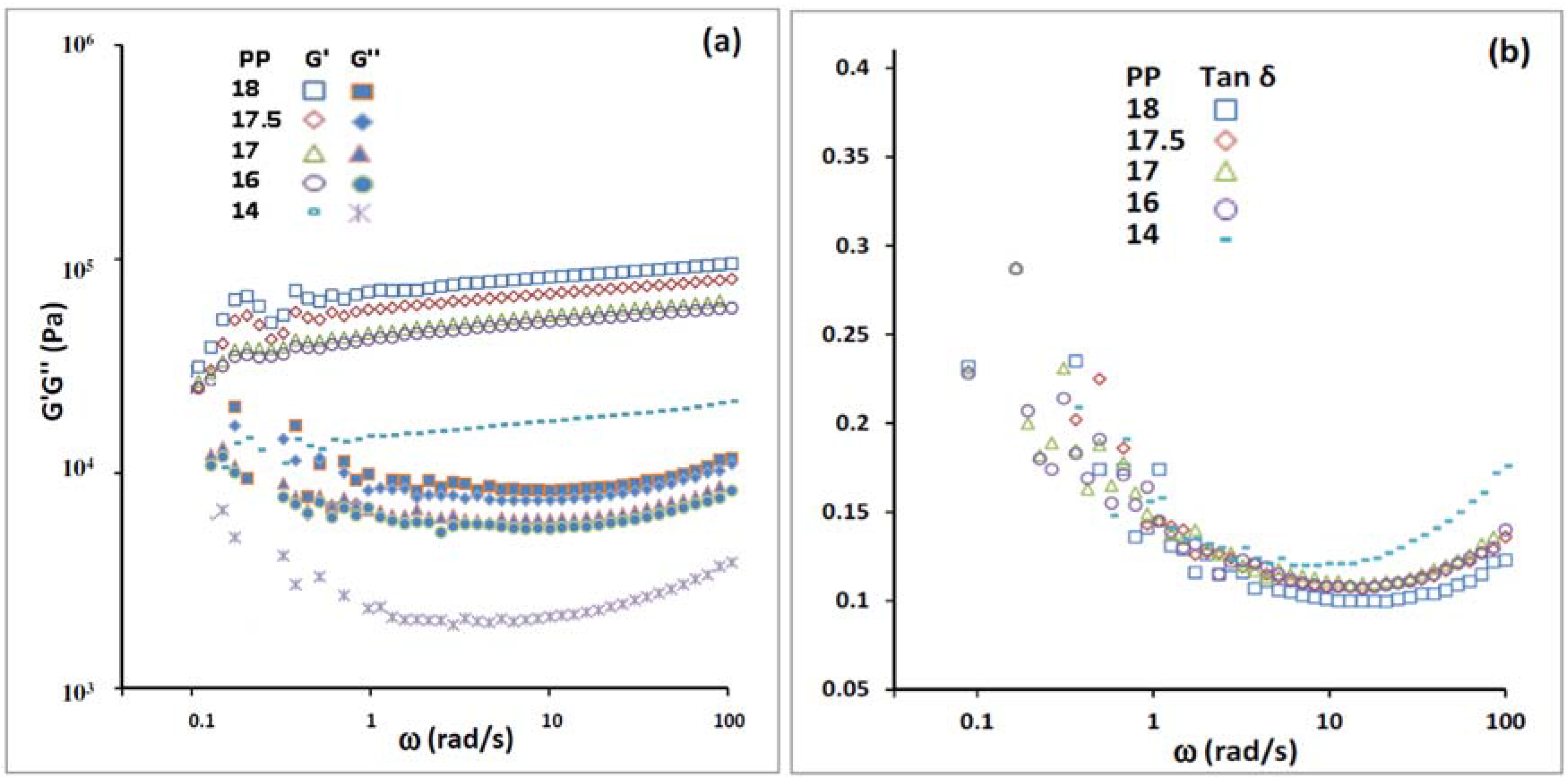
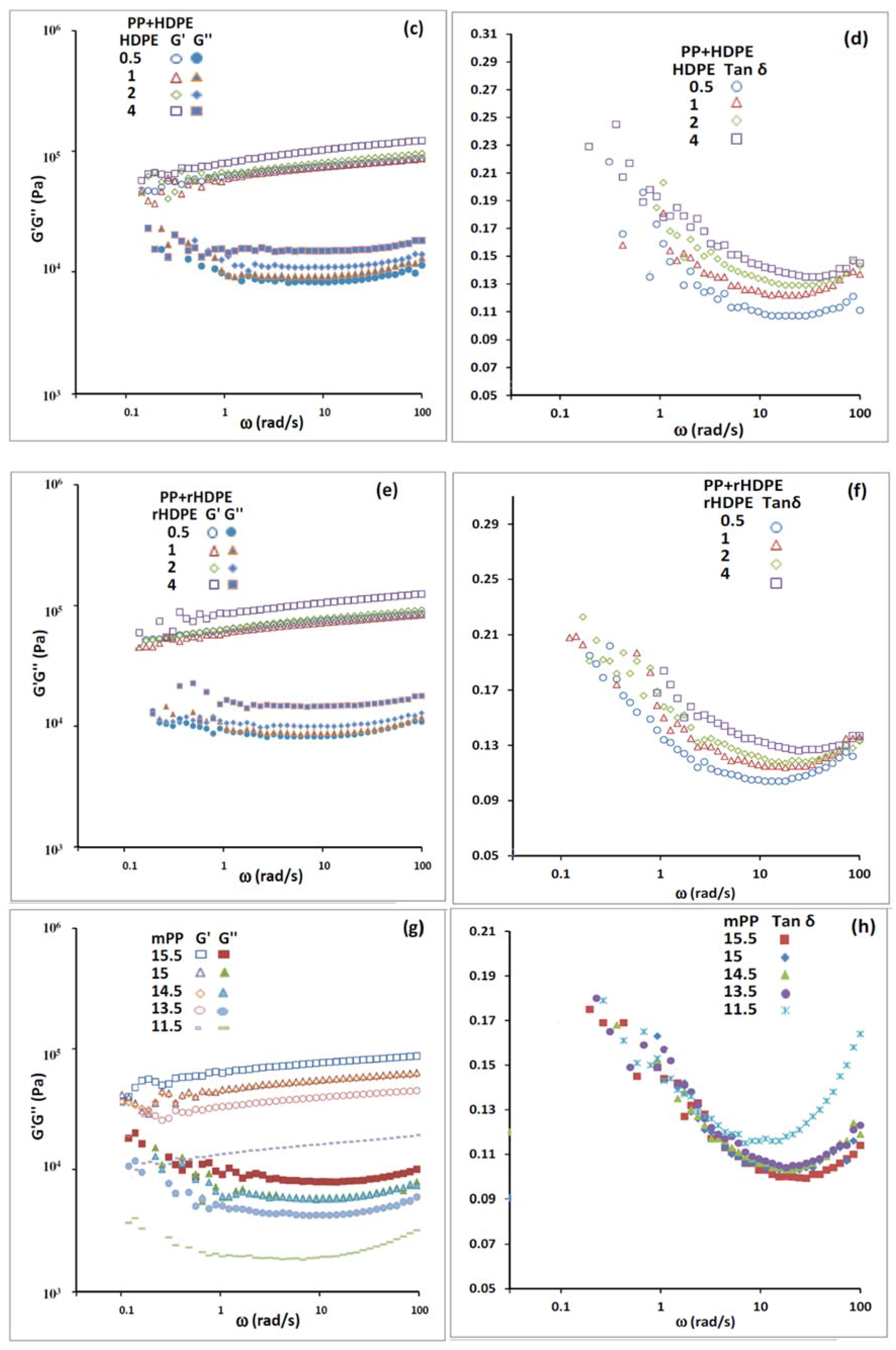
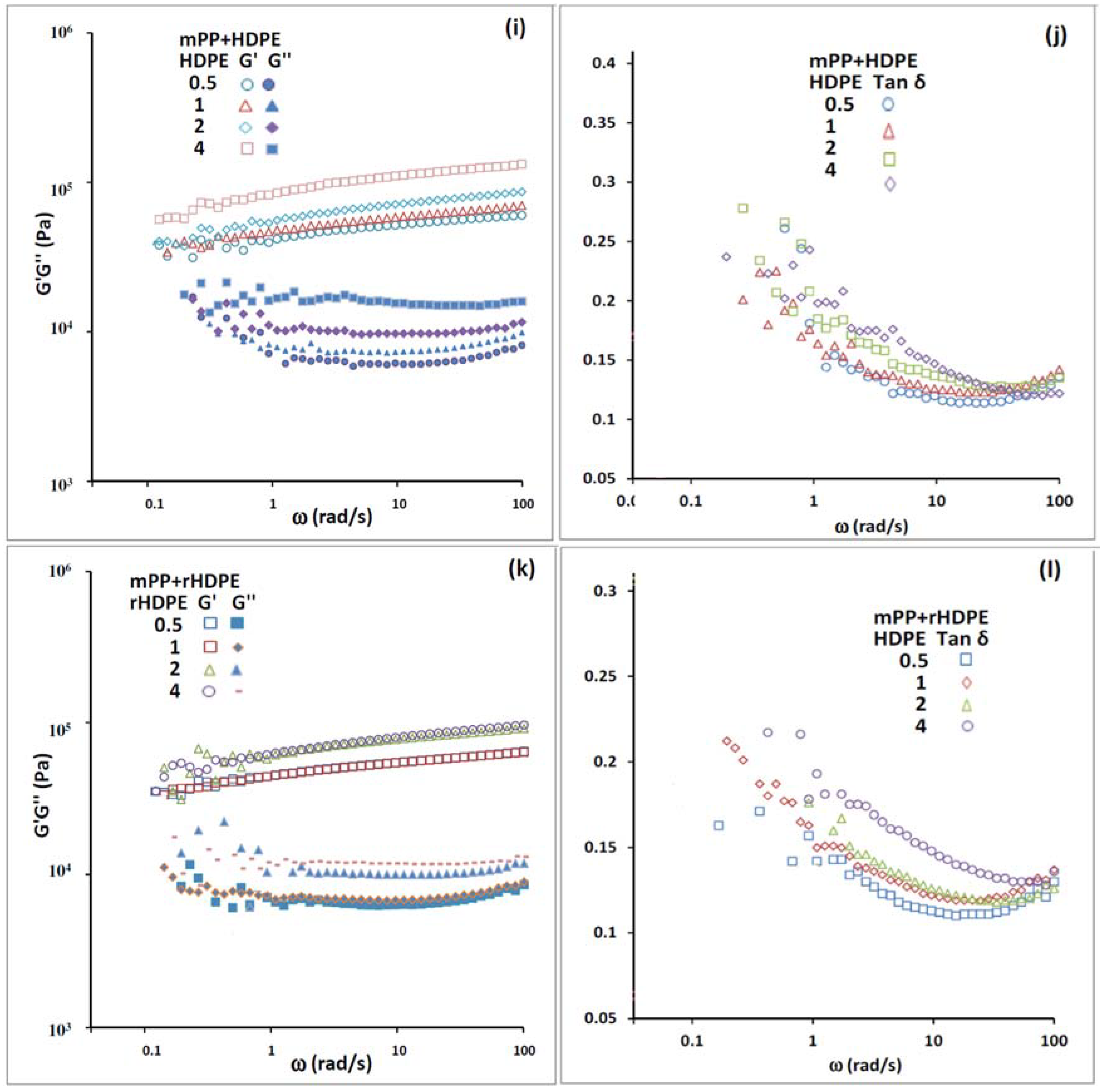
4. Conclusions
- Both PP and mPP exhibit similar oil bleed tendencies. However, mPP shows a slightly higher thickening tendency with the same thickener concentration over PP.
- HDPE increased G′ and G″ values of PP and mPP greases thereby inhibiting oil bleed tendency.
- The oil bleed inhibiting tendency of these modified greases is sensitive to temperature, HDPE content and overall thickener content.
- The oil bleed tendency of greases varies from thickener to thickener but grease with same thickener type tends to bleed more oil which has comparatively higher viscous response (high G″) than elastic (low G′).
Acknowledgments
Author Contributions
Conflicts of Interest
References
- Rizvi, S.Q.A. Lubricant Chemistry, Technology, Selection, and Design; ASTM International: West Conshohocken, PA, USA, 2009; p. 443. [Google Scholar]
- NLGI. Lubricating Grease Guide; National Lubricating Grease Institute: Kansas City, MO, USA, 1987. [Google Scholar]
- Delgado, M.A.; Valencia, C.; Sanchez, M.C.; Franco, J.M.; Gallegos, C. Influence of soap concentration and oil viscosity on the rheology and microstructure of lubricating greases. Ind. Eng. Chem. Res. 2006, 45, 1902–1910. [Google Scholar] [CrossRef]
- Couronne, I.; Vergne, P.; Mazuyer, D.; Troung-Dinh, N.; Girodin, D. Effects of grease composition and microstructure on film thickness in rolling contact. Tribol. Trans. 2003, 46, 31–36. [Google Scholar] [CrossRef]
- Baart, P.; Vorst, B.V.D.; Lugt, P.M.; Ostayen, R.A.J.V. Oil-bleed model for lubricating grease based on viscous flow through a porous microstructure. Tribol. Trans. 2010, 53, 340–348. [Google Scholar] [CrossRef]
- Mittinen, J.; Andersson, P.; Wikstro, V. Analysis of grease lubrication of a ball bearing using acoustic emission measurement. J. Eng. Tribol. 2001, 215, 535–544. [Google Scholar]
- Yuka, C.; Kogyo, K.K. Non-Diffusive Grease. JP Patent 63057693A, 1988. [Google Scholar]
- Takahashi, O.; Kume, M. A study on non-oil diffusive greases. NLGI Spokesm. 1999, 57, 25–30. [Google Scholar]
- John, A.; Waynick, B. Polyurea Grease with Reduced Oil Separation. U.S. Patent 4759859, 1988. [Google Scholar]
- Meijer, D. Polymer Thickened Lubricating Grease. Eur. Patent 0700986B1, 1995. [Google Scholar]
- Meijer, D.; Lankamp, H. Polymer Thickened Lubricants for High Temperatures. U.S. Patent 5846918, 1998. [Google Scholar]
- Martin-Alfonso, J.E.; Valencia, C.; Sanchez, M.C.; Franco, J.M.; Gallegos, C. Development of new grease formulations using recycled LDPE as rheology modifier additive. Eur. Polym. J. 2007, 43, 139–149. [Google Scholar] [CrossRef]
- Martin-Alfonso, J.E.; Valencia, C.; Sanchez, M.C.; Franco, J.M.; Gallegos, C. Evaluation of different polyolefins as rheology modifier additives in lubricating grease formulations. Mater. Chem. Phys. 2011, 128, 530–538. [Google Scholar] [CrossRef]
- Polyshuk, T.A.; Johnson, H.L. Grease Composition Containing Atactic Polypropylene. U.S. Patent 3290244, 1966. [Google Scholar]
- Martin-Alfonso, J.E.; Romero, A.; Valencia, C.; Franco, J.M. Formulation and processing of virgin and recycled polypolefin/oil blends for the development of lubricating greases. J. Ind. Eng. Chem. 2013, 19, 580–588. [Google Scholar] [CrossRef]
- Bill, M. Grease. U.S. Patent 3392119A, 1665. [Google Scholar]
- Yao, C. Maleated Polypropylene Blend for Melt-Bonding Applications. Eur. Patent 0408470 A1, 1991. [Google Scholar]
- Mishra, M.K.; Rubbin, I.D. Functionalized Graft Co-Polymer as a Viscosity Index Improver, Dispersant, and Antioxidant Additive and Lubricating Oil Composition Containing Same. U.S. Patent 5409623, 1995. [Google Scholar]
- Keener, T.J.; Stuart, R.K.; Brown, T.K. Maleated coupling agents for natural fibre composites. Appl. Sci. Manuf. 2004, 35, 357–362. [Google Scholar] [CrossRef]
- Cann, P.M. Starved grease lubrication of rolling contacts. Tribol. Trans. 2008, 42, 867–873. [Google Scholar] [CrossRef]
- Martin-Alfonso, J.E.; Valencia, C.; Sanchez, M.C.; Franco, J.M.; Gallegos, C. Rheological modification of lubricating grease with recycled polymers from different plastic waste. Ind. Eng. Chem. Res. 2009, 48, 4136–4144. [Google Scholar] [CrossRef]
- Meijer, D. Polymer Thickened Lubricating Grease. Eur. Patent 0700986 B1, 1995. [Google Scholar]
- Martin-Alfonso, J.E.; Valencia, C.; Franco, J.M. Effect of amorphous/recycled polypropylene ratio on thermo-mechanical properties of blends for lubricating applications. Polym. Test. 2013, 32, 516–524. [Google Scholar] [CrossRef]
- Martin-Alfonso, J.E.; Moreno, G.; Valencia, C.; Sanchez, M.C.; Franco, J.M.; Gallegos, C. Influence of soap/polymer concentration ratio on the rheological properties of lithium lubricating greases modified with virgin LDPE. J. Ind. Eng. Chem. 2009, 15, 687–693. [Google Scholar] [CrossRef]
© 2014 by the authors; licensee MDPI, Basel, Switzerland. This article is an open access article distributed under the terms and conditions of the Creative Commons Attribution license (http://creativecommons.org/licenses/by/4.0/).
Share and Cite
Dixena, R.; Sayanna, E.; Badoni, R. Recycled and Virgin HDPEs as Bleed Inhibitors and Their Rheological Influences on Lubricating Greases Thickened with PP and mPP. Lubricants 2014, 2, 237-248. https://doi.org/10.3390/lubricants2040237
Dixena R, Sayanna E, Badoni R. Recycled and Virgin HDPEs as Bleed Inhibitors and Their Rheological Influences on Lubricating Greases Thickened with PP and mPP. Lubricants. 2014; 2(4):237-248. https://doi.org/10.3390/lubricants2040237
Chicago/Turabian StyleDixena, Ravi, Eltepu Sayanna, and Rajendra Badoni. 2014. "Recycled and Virgin HDPEs as Bleed Inhibitors and Their Rheological Influences on Lubricating Greases Thickened with PP and mPP" Lubricants 2, no. 4: 237-248. https://doi.org/10.3390/lubricants2040237




